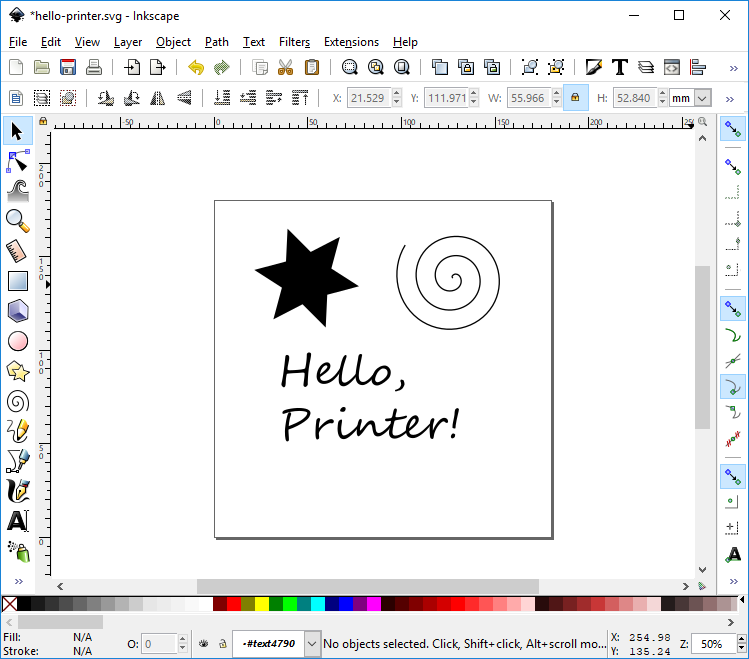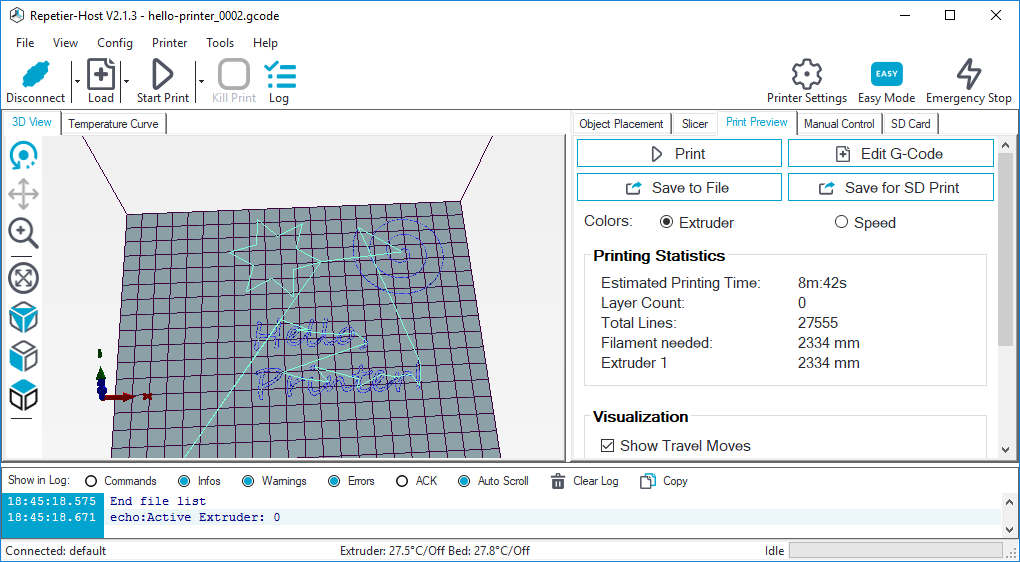images for 3d printer how to draw
How to Turn Your 3D Printer into a Plotter in One Hour
Teach Your 3D Printer How to Draw and Write on Paper with Pens, Color Pencils, Crayons and More! 🖍
Building a plotter was on my list for a long time. A plotter is a device that can draw text and pictures on paper using a pen. A few weeks ago, later fellow Israeli makers built a small plotter from former CD drives, I decided it was finally time to build my ain plotter.
I sat downwards and started planning the hardware, when I suddenly realized that there might be a squeamish shortcut — my 3D printer already includes all the hardware and electronics I need, I just need to effigy out how to attach a pen to it and how to tell it to describe.
One hour subsequently I had a working prototype. It was much easier than I initially expected. In this blog post yous volition learn how you can make your own printer describe.

Turning a 3D Printer into a 2D Printer 🖨
You lot might exist wondering what is the utility in turning a 3D printer into something that can draw second pictures on a newspaper. After all, conventional printers exercise that for several decades already, isn't that a step backward?
First, who said everything I brand has to be useful?
Second, a plotter allows you lot to draw with pen, colored pencils, crayons, markers, and even a quill. Basically everything that tin can leave marks on a slice of paper. You even draw on dissimilar materials, such as paper-thin or glass. You tin too get artistic with unique ink types, such as gilded, silvery or glow-in-the-dark —you proper name it.
Stride 1 — Attaching a Pen
Yous want to reliably mount a pen to your printer'south caput and ensure that the tip of the pen goes a little below the nozzle. I started by designing a small function of this purpose. It clips to the printer's caput, and I use a small M3 spiral to fix the pen to it:
You tin get the model here. It should fit any Creality Ender-iii or CR-20 printer, and possibly other Creality printers. It is also customizable, then you tin tinker with the dimensions (if y'all want to fit a larger mark, or need a tighter fit with the printer).
For other printers, you will need to design your own mounting mechanism (when you practice, please share a link in the comments). While is it likewise possible to use screws for mounting the pen, I personally prefer the clipping mechanism as information technology allows me to switch between 3D printer and plotter modes actually quickly, and also change pens really quick.
Step 2 — Scale
One time y'all have successfully mounted your pen to your printer, it'southward time to calibrate information technology. You will need to attach a piece of paper to your printer's bed:
Next, you volition need to find the correct acme for printing. I recommend using Repetier Host for this (I initially started with Cura, but Repetier Host made everything much easier, so I will stick with it for this tutorial).
Earlier starting, make sure your printer's bed is level and that both the nozzle and the printer bed are cool.
After homing your printer, go to the "Manual Command" tab inside Repetier, and move the print head up until the tip of the pen goes above the paper. Then, move your X / Y axis to the edge of where you want your cartoon to exist. Finally, move the Z axis down in 0.1mm increments, until yous encounter the tip of the pen touching the paper. You can and so motility the Ten/Y a fiddling and check that the pen really leaves a trace on the newspaper. When done, note the X/Y/Z values that announced in the top line:

In my instance, the values were 47 for X, 40 for Y and fourteen.half-dozen for Z. We will use these values before long when we generate the GCode file for press.
Step 3— Choosing a what to print
That'due south a tough 1. So many options. Y'all will need to get it in vector format, though — and so if you employ Google Images, add the text blazon:svg at the stop of your search query. You tin too convert JPEG and PNG images to SVG, just I'd advise to start with something that already comes every bit a vector to make things simple.
Step 4 — Generating GCode
When I started this project, I idea I was going to spend some hours on getting the hardware right. I was surprised how quickly I got the hardware part working. The software was, however, a completely dissimilar story — as always, software is where the real complexity lies.
After spending several hours on research, I finally establish a workflow that works pretty reliably, though, it requires some setup. Other than Repetier Host mentioned above, y'all also need to become Inkscape (which is, by the mode, as well useful if you desire to create PCB fine art!).
Inside Inkscape, create a new file and go to File menu → Document Properties (Shortcut: Ctrl+Shift+D). And so set the document size a trivial smaller than your impress bed size, and also make sure you utilise mm for the units.

In one case you have set the size, you tin can import any SVG file that you like, or but draw some text using the Text tool:

When done, with the text still selected, click on Path menu → Object to Path (Shift+Ctrl+C). This will convert the text into a series of points connected past lines, which is required for feeding into the printer. Yous tin can add together more than elements such as spirals and star shapes, repeating the "Object to Path" functioning for each:

When printing, objects won't be filled, so you lot may desire to remove their fill color and set up their stroke colour to blackness (or whatever colour your pen is), then y'all get a more than accurate representation of the final result. Select all the objects (Ctrl+A) and and then remove the fill up and employ black color for stroke (Ctrl+Shift+F):

When you are happy with the result, information technology is time to generate the GCode for the printer! We will use an extension called "Gcodetools", which comes bundled with Inkscape (if not, yous have an older version and need to upgrade).
We will starting time by defining the Orientation Points, which tell the printer how to map the lines on screen onto the paper. Go to Extensions Carte → Gcodetools → Orientation Points… and after making sure "2-point" fashion is selected click Utilize and then Close. Yous should now see ii new text elements added at the bottom of your cartoon:

These are the Orientation Points. Each point is a listing of X, Y, Z coordinates that specifies the target location of that signal in the Printer's coordinate organisation. You need to edit them to friction match the X / Y you establish in the scale step, and set the Z (the 3rd coordinate) to 0.
Edit the text on the left point and update information technology to incorporate the 10 / Y coordinates that you found. In my case, it was (47; 40; 0). For the right point, add together 100 to the X value, re-create the Y/Z from the commencement one, due east.1000. (147; 40; 0):

Next, we demand to generate a tool and configure its speed. This stride is optional, but if you lot don't do this, your printer will draw really really slow. Become to Extensions menu → Gcodetools → Tools Library…, and select "default" in "Tool types":

Click Utilise and so Close, and you lot should encounter a green rectangle with a lot of settings added to your cartoon:

You can movement this rectangle abroad (together with all the values) so it doesn't come over your cartoon. So, you want to edit the text and modify the values for "Feed", "Penetration Feed", "Passing Feed" to set the motility speed of the printer when cartoon. I use 4500 for all of them (the unit is mm/min, and so this value corresponds to 75 mm/sec).

Nosotros are finally ready to generate the GCode! Select all the elements in your drawing (Ctrl+A), and go to Extensions → Gcodetools → Path to Gcode…
There, go to the Options tab, and ready "Scale along Z axis" to i, and "Get-go along Z axis" to the Z value that you found in the calibration stride, minus ane (I found xiv.6, so I fix it here to thirteen.half dozen):

Side by side, go to the Preferences tab, and set the proper noun of the output file and the path of the directory when you want information technology to be saved. You can likewise set the Z safety height to a lower value, to speed upwards the impress (I apply 5):

Finally, switch to the Path to Gcode tab, set the Depth Function to i and click Apply. It will take a few seconds and might spit a warning well-nigh no paths selected which you can safely ignore. You should run into a new layer on tiptop of your drawing, showing the moves of the print-head in the generated Gcode file:

At this signal, I advise opening the .gcode file in a text editor and verifying that the information technology looks legit — especially that the Z values at that place match the calibration value that you institute:

I besides propose editing the first G00 line and adding F4500 at the end, otherwise, your printer might make the initial head movement actually ho-hum:

That's it! You lot are fix to print. Load your Gcode file in Repetier host, and y'all should see your drawing on the screen:

Say your prayer, click the "Offset Print" button and… enjoy the show!
Congratulations! 🎉
Your 3D printer now also doubles as a plotter. You can take it one step farther and experiment with the different settings of Gcodetools — for instance, you can configure information technology to change the height of the pen co-ordinate to the color of the line, thus making the plotter describe thinner/thicker lines. You can also use the "Area" office to fill up shapes instead of just drawing the outline. ⭐
Please proceed experimenting and try different types of pens and materials, and post you lot results in the comments — I'd love to see how far you tin take this!
This is my fifth post in my Postober challenge — writing something new every unmarried day throughout Oct.
I will tweet whenever I publish a new mail, promise! ✍
Source: https://urish.medium.com/how-to-turn-your-3d-printer-into-a-plotter-in-one-hour-d6fe14559f1a
0 Response to "images for 3d printer how to draw"
Enregistrer un commentaire